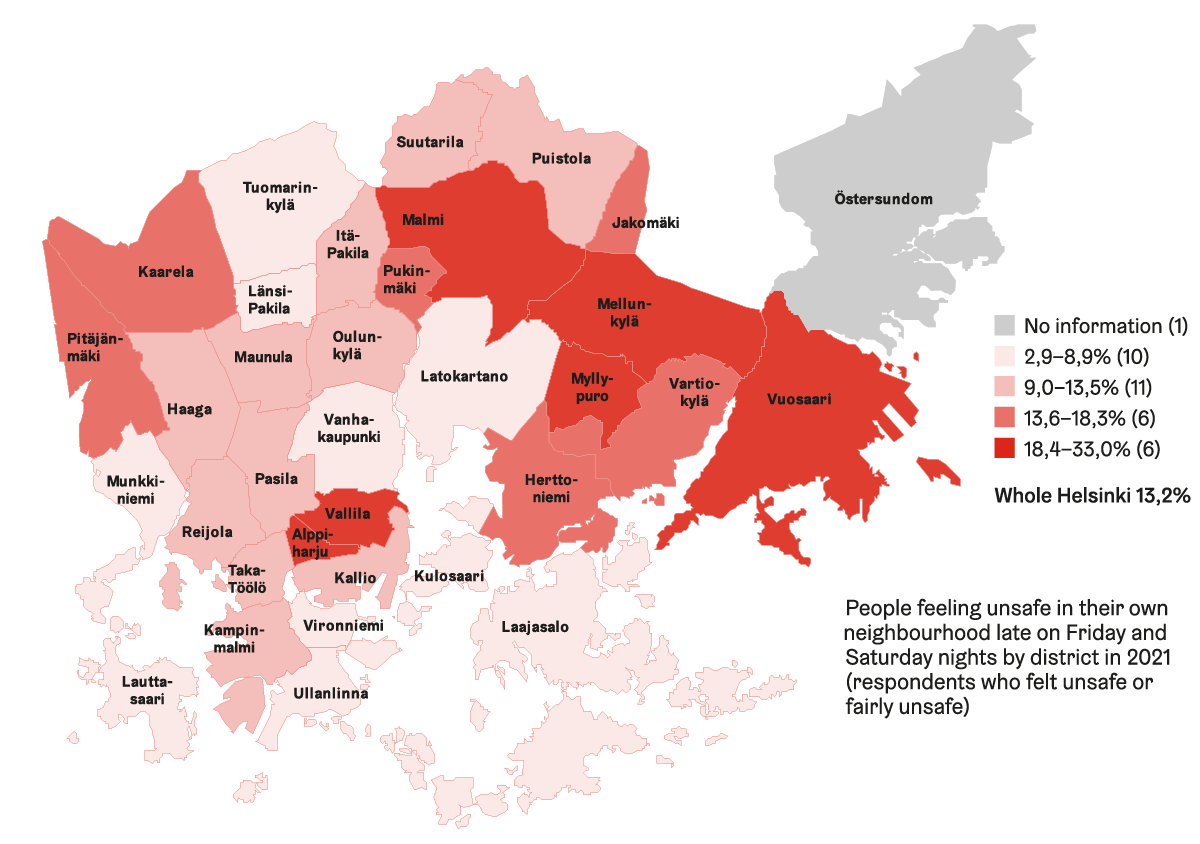


According to the latest Helsinki Safety Survey conducted in 2021, 89% of residents consider Helsinki to be safe. The number of people who consider Helsinki to be safe has decreased by 3 percentage points since 2018. In 2021, changes in the mobility of urban residents caused by the COVID-19 pandemic had an impact on the statistics: for example, in the autumn of 2021, the number of people using the city centre was 30–50% lower than before the pandemic, depending on the week. In terms of crime, Helsinki is still a very safe city by Nordic standards. The total number of all crimes has mostly been on a downward trend since 1990, both nationally and in Helsinki. However, the number of crimes against life and health has been on an upward trend. According to preliminary information, in 2022 crimes against life and health increased by 8.5% in Helsinki compared to the previous year. Around 95% of crimes against life and health are assault offences.
The differences in perceived safety between neighbourhoods have not diminished. Experiences of insecurity are concentrated in areas that score poorly on socio-economic indicators, and there are also gender differences in perceived safety. There are significant differences between the neighbourhoods of Helsinki in how safe their residents perceive their area to be. In some areas, around one in three people feel unsafe in their neighbourhood late on Friday and Saturday nights, while only three per cent of respondents in the areas perceived to be safest report this. Even though the differences in experiences of insecurity between neighbourhoods are significant, they have remained fairly similar compared to previous surveys. In most areas, the situation has remained very stable, and only in rare areas has insecurity either increased or decreased significantly.
When asked about their own neighbourhood, Helsinki residents are most concerned about the loss of green spaces, vandalism and social exclusion. According to the latest Safety Survey, there is more concern about signs of social disorder in the neighbourhood than in the mid-2010s. Vandalism, the loss of green spaces and social exclusion were the most common causes of concern.
According to the analysis of the urban safety environment in Helsinki, the themes that cause the most concern are the decreased wellbeing of young people and its effects, and the increase in substance abuse. These themes are also at the heart of the safety work carried out by the City.
Helsinki City Group’s significant risks
The City Group’s significant risks are those strategic, financial, operational and external risks that threaten the Group’s objectives or otherwise have a very large impact if they materialise.
The City Group’s significant risks are assessed in a separate process each council term. One of the basic tasks of the City Group’s internal monitoring and risk management coordination group is to assist the Group’s management by identifying and assessing the Group’s most significant risks and methods to manage them.
In the 2022 assessment, the divisions, enterprises and largest subsidiaries were asked to identify the three most significant risks for the City Group and one emerging risk or weak signal from the operating environment that could become significant in the future. In addition to this, as a new experiment in this assessment round, the City’s staff were also asked to comment on the Group’s significant risks and emerging risks / weak signals in the City’s intranet. The survey was taken by 108 employees.
Violence in close relationships
Helsinki recruited a coordinator for the prevention of violence in close relationships for a fixed-term position in 2022–2023 to promote the prevention of violence in close relationships and improve wellbeing and safety. The coordinator prepares an action plan for the prevention of violence in close relationships for the City in cooperation with the working group on the prevention of violence in close relationships. In addition to City operators, the working group includes organisations, THL, the Helsinki Police Department, HUS and the prosecuting authority. The working group maintains a situational picture of violence in close relationships in Helsinki and Finland and has provided staff with training on the subject, taking into account the gendered nature of violence in close relationships and particularly vulnerable population groups.
The working group has carried out the ‘You can be hurt even by a loved one’ campaign, aiming to raise children and young people’s awareness of violence in close relationships and increase the skills of the Education Division’s staff to identify and intervene in cases of violence in close relationships. In Helsinki, the amount of violence in close relationships experienced by children and young people in particular increased during the pandemic, and this needed to be addressed. Mental violence experienced by young girls in Helsinki had increased by 10% between the previous School Health Promotion Studies. Several measures for the prevention of violence in close relationships have been targeted at children and young people as part of the Future Health and Social Services Centre project. According to the Helsinki Metropolitan Area Wellbeing Questionnaire 2021, 3.2% of adult women and 2.5% of men in Helsinki had experienced violence in a close relationship or the threat of it, and 2.6% of women and 2.1% of men had experienced intimate partner violence or the threat of it in the previous year.
The number of calls to the Nollalinja helpline for victims of violence in close relationships increased by 31%, and the number of people seeking help from Victim Support Finland increased by 25%. The ‘Mehut loppu’ campaign in 2021 sought to reach both victims and perpetrators of violence in close relationships. The City carried out the campaign in cooperation with organisations, THL, the Helsinki Police Department and HUS.
Experiences of insecurity by basic district

Risks and SDGs

Successes:
- Despite the exceptional year 2021, the safety situation in Helsinki has remained unchanged for both men and women.
- Finland and Helsinki are known for the concept of overall safety, and the City aims to promote this perspective.
Areas for development:
- Violence in close relationships remains a problem, especially violence against women, and the COVID-19 crisis seems to increase violence in homes.
- There are differences in perceived safety, both between genders and between residential areas. Violence against women in close relationships must be reduced.
Programmes and studies:
City of Helsinki Safety Plan summary PDF
Results of the Helsinki Safety Survey in Kvartti, Helsinki quarterly (in Finnish)
Helsinki Safety Survey 2018 PDF (in Finnish, preface and summary in English)


